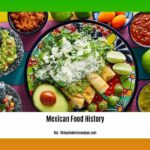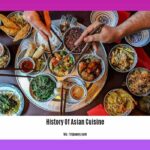Ancient Roman civilization, renowned for its formidable legions and architectural marvels, also boasted a complex and fascinating food culture. Far from a mere necessity, food in Rome played a pivotal role in defining social status, celebrating life’s major milestones, and even influencing political stability. This Informative and Instructional Guide provides an in-depth exploration of Roman dietary habits, contrasting the lavish feasts of the elite with the staple meals of the common citizen, and offering practical methods for engaging with this rich culinary history. Roman pottery was also essential for daily life; see examples of ancient Roman pottery. We aim to illuminate the enduring legacy of ancient Roman cuisine, revealing how its principles of seasonality, sustainability, and resourcefulness continue to offer valuable lessons for contemporary diets.
Here are three fundamental aspects of Roman food culture:
- Profound Social Stratification: Dining experiences in ancient Rome were starkly differentiated by social class. The wealthy enjoyed a diverse array of often-imported delicacies, while the less affluent relied predominantly on basic grains and legumes.
- Garum’s Pervasive Influence: Garum, a fermented fish sauce, was the indispensable and pervasive condiment of Roman cooking. It functioned as an all-purpose flavor enhancer, adding depth and umami to virtually every dish, from complex stews to simple vegetables.
- Timeless Adaptability: The core tenets of ancient Roman food — emphasizing local, seasonal ingredients, minimal waste (e.g., “quinto quarto”), and uncomplicated preparation — resonate strongly with modern dietary trends, fostering both historical appreciation and culinary innovation.
Exploring Ancient Roman Food: Daily Life, Essential Ingredients, and Societal Impact
Embark on a culinary journey into the delectable and diverse world of ancient Roman food. This exploration transcends modern Italian cuisine, delving into a period long before the introduction of essential ingredients like tomatoes and potatoes. Understanding Roman food requires recognizing the profound influence of social standing on one’s dining experience, as well as the fundamental ingredients that formed the bedrock of their daily sustenance.
The Foundation: Core Ingredients of the Roman Diet
Regardless of social standing, the fundamental diet of ancient Romans revolved around staple items: grains, vegetables, and olive oil. This dietary approach, reminiscent of the early Mediterranean diet, was largely plant-based and celebrated for its inherent health benefits. Wheat and barley were paramount, typically prepared as robust bread or a thick, nourishing porridge known as puls. These grains were complemented by a wide variety of vegetables, forming the essential caloric and nutritional backbone of Roman sustenance. Common vegetables included cabbage, lettuce, leeks, onions, asparagus, radishes, turnips, parsnips, and carrots (though not typically orange varieties). Legumes such as lentils, chickpeas, and various beans provided crucial protein, especially for those with limited access to meat. Fruits like apples, pears, figs, grapes, and dates were consumed fresh when in season and preserved through drying for colder months, showcasing Roman ingenuity in food preservation.
Garum: The Quintessential Roman Flavor Enhancer
Envision a sauce so deeply savory and universally essential that it permeated nearly every dish. This was garum, a fermented fish sauce, the ubiquitous condiment of the Roman world. Crafted from fish parts allowed to ferment over weeks or months, garum was the ancient Roman equivalent of soy sauce or the fish sauce found in many Asian cuisines. It functioned as an all-purpose flavor enhancer, adding remarkable depth, umami, and a distinctive savory punch to countless dishes. Its widespread use, from meats and stews to vegetables and even desserts, underscores its fundamental importance in Roman cooking. While its precise flavor profile remains a subject of debate among food historians, it is widely believed to have offered a potent, rich, and intensely savory taste, akin to a very strong anchovy paste. The most prized varieties, such as garum sociorum from Spain, commanded exceptionally high prices, reflecting its value and the sophisticated trade networks that distributed it across the empire.
Wine: A Cornerstone of Roman Social and Daily Life
Wine, typically consumed diluted with water to temper its potency, was a pervasive beverage enjoyed across most social strata in ancient Rome. It transcended its role as a mere drink; it was an integral component of daily meals, social gatherings, and religious rituals. Roman viticulture was extensive, with historical records and archaeological findings pointing to favored wines from regions like Campania and Latium, producing diverse vintages. Mulsum, a popular aperitif, combined wine with honey, while posca, a mixture of sour wine, water, and herbs, was a common, bracing drink for the lower classes and a staple ration for Roman soldiers due to its purported health benefits in poor water conditions. Beer (cerevisia) was known but considered a “barbarian” drink, rarely consumed by mainstream Roman society.
A Stratified Palate: How Social Standing Defined Roman Cuisine
In ancient Rome, an individual’s diet was profoundly shaped by their social class. The wealthy indulged in an unparalleled array of meats, rare imported spices, exotic delicacies, and elaborately prepared multi-course meals, meticulously showcasing their affluence and sophisticated palate. In stark contrast, the less affluent primarily subsisted on basic grains, legumes, and locally grown vegetables, preparing simpler, more rustic fare. This dramatic divergence in diet created two distinct culinary worlds coexisting simultaneously.
Consider this table summarizing the dietary disparities:
| Feature | Wealthy Romans | Poor Romans |
|---|---|---|
| Staple Foods | Diverse meats (including exotic game), imported grains, fresh fruits | Simple grains (wheat, barley), legumes, locally grown vegetables |
| Cooking | Sophisticated, diverse culinary techniques; extensive use of spices | Basic, practical preparations, often boiled or stewed |
| Dining | Lavish banquets with multiple courses, reclining on couches | Simple, utilitarian meals, often eaten quickly and seated or standing |
| Ingredients | Exotic spices from distant lands, imported delicacies, fine wines | Seasonally available, locally sourced ingredients, basic cereals |
| Example Meal | Roasted peacock with complex sauces (a luxury and status symbol) | Hearty grain porridge (puls) with lentils (a common, nutritious staple) |
Roman Meal Structure: From Dawn to Dusk
The rhythm of Roman life was punctuated by three main meals, though their timing and substance evolved over centuries:
- Ientaculum (Breakfast): Served at dawn, this was a modest affair, typically consisting of bread (often dipped in wine or olive oil), sometimes with salt, honey, or leftovers from the previous evening’s meal.
- Prandium (Lunch): A light mid-day meal, designed to sustain Romans until the main evening meal. It often comprised cold meats, cheese, fruits, and bread. For the working classes, it remained a simple meal, while the elite might visit the public baths after their prandium.
- Cena (Dinner): Originally the main meal eaten at midday, the cena gradually shifted to the evening among the upper classes as foreign foods became more accessible and lavish dining became a display of wealth. This could be a lengthy and elaborate affair, especially if guests were invited, often followed by a comissatio (a dedicated session of drinking wine). For the poor, the cena remained a simpler, staple-focused meal, often puls or bread with vegetables.
Food Preservation: An Ancient Art
Given the lack of refrigeration, Romans developed sophisticated methods for food preservation, ensuring a continuous supply of sustenance:
- Drying: Fruits (figs, grapes) and vegetables were commonly sun-dried.
- Salting: Meats (especially pork) and fish were heavily salted to extend their shelf life. Salt also played a vital role in the production of garum.
- Smoking: Some meats were smoked, imparting flavor and preserving them.
- Honey and Vinegar: These were used as preservatives for fruits and vegetables, and as bases for various sauces and condiments.
- Brine: Vegetables and even some fish were pickled in brine or vinegar.
- Amphorae: Wine and olive oil were stored in large ceramic amphorae, often sealed with resin or wax to prevent oxidation. Grain was stored in purpose-built granaries.
Food Supply and Public Access
The burgeoning population of Rome created an immense demand for food, necessitating a robust supply chain. Private enterprises largely met the needs of citizens, with foodstuffs primarily sourced from the Italian mainland and large islands like Sicily and Sardinia.
- Frumentatio: From 123 BCE, the Roman state began distributing monthly rations of unmilled wheat (frumentatio) to up to 200,000 citizens in Rome. Originally a small charge, this was abolished in 58 BCE, making it a free distribution for registered citizens. In later imperial periods, this expanded to include olive oil and pork for poorer citizens.
- Macellum (Public Markets): Romans purchased their food at public markets (macellum), held daily in Rome (e.g., Trajan’s Market) and weekly in provincial towns. These markets were vibrant hubs of commerce and social interaction, offering a wide array of produce.
- Thermopolia and Popinae (Eateries): For those who couldn’t cook at home or preferred convenience, thermopolia (hot food stands) and popinae (taverns) offered prepared meals and cheap wine. These establishments, often frequented by the lower classes, served “fast food” like mulled wine, baked cheeses, lentils, and meats, usually for consumption on the go. While not equivalent to modern restaurants, they filled a similar niche.
Bridging Millennia: Bringing Ancient Roman Flavors to Your Kitchen
Do you desire to experience the taste of history in your own kitchen? While perfect replication of ancient Roman food is challenging due to lost ingredients and techniques, authentic adaptations are entirely achievable. Ongoing archaeological discoveries and culinary research continuously offer new insights, making this an exciting area for gastronomic exploration.
A Step-by-Step Guide to Crafting an Ancient Roman-Inspired Meal:
- Embrace Heritage Grains: Seek out ancient wheat varieties like spelt or emmer. Their distinct, earthy flavor provides a more historically accurate foundation for your dishes.
- Prioritize Legumes: Incorporate lentils, chickpeas, and various beans generously. These were common staples, offering both protein and texture essential to the Roman diet.
- Invest in Quality Olive Oil: Use high-quality extra virgin olive oil liberally. It was not merely a cooking fat but a fundamental flavor component, utilized across all social strata.
- Consider Fish Sauce (Judiciously): Authentic garum is rare, but a high-quality modern Asian fish sauce can provide a similar umami depth. Use it with restraint, as its intensity can be potent.
- Utilize Aromatic Herbs and Spices: The Romans employed a rich array of herbs like rosemary, thyme, oregano, and mint. Spices such as cumin, coriander, and black pepper were also vital for enhancing flavor.
- Pair with Italian Wine: Select a dry red or white wine from Italy to complement your meal, honoring the Roman tradition of wine consumption and enhancing the historical immersion.
Market Opportunities: Food Producers and Retailers
The growing interest in historical diets and unique culinary experiences presents significant opportunities for food producers and retailers. They can capitalize on this fascination, tapping into a niche market of history enthusiasts and adventurous foodies.
| Opportunity | Description | Potential Benefits |
|---|---|---|
| Heritage Grain Sourcing | Source and promote ancient grain varieties (e.g., spelt, emmer) used in Roman times. | Appeals to consumers seeking authentic, nutrient-dense, and unique ingredients. |
| Roman-Inspired Product Lines | Develop sauces, dressings, and spice blends inspired by ancient Roman cuisine. | Capitalizes on the trend for unique, historically-informed, and gourmet flavors. |
| Recipe Kits and Meal Boxes | Create convenient kits with pre-portioned ingredients and easy-to-follow Roman-inspired recipes. | Offers convenience, encourages culinary experimentation, and boosts consumer engagement. |
Educational Engagement: Museums and Schools
Museums and educational institutions possess unique avenues to engage the public with the captivating world of ancient Roman cuisine, transforming history into a tangible and delicious experience. Experiential learning approaches significantly enhance knowledge retention and appreciation.
- Interactive Exhibitions: Design immersive exhibits showcasing the evolution of Roman eating habits, including archaeological findings of food remnants, culinary tools, and reconstructed kitchens.
- Virtual Reality Tours: Offer immersive virtual tours of reconstructed ancient Roman kitchens or elaborate dining rooms (triclinia), providing rich contextual understanding.
- Hands-On Workshops: Host practical cooking workshops where participants can learn to prepare simple, adapted Roman dishes, fostering direct engagement and skill development.
- Integrated Educational Programs: Weave Roman food culture into broader history, economics, and social studies curricula, exploring its profound links to daily life, trade, and societal structures.
The goal is to bring history vibrantly to life, creating memorable and educational experiences for learners of all ages.
Mastering the Ubiquitous: How to Make a Garum Substitute
Key Takeaways:
- Garum was a vital fermented fish sauce in Roman cuisine, providing essential salt and umami.
- Historical production of garum varied, with liquamen (often from whole fish) being more common for everyday use, while garum (from fish blood and innards) was typically a more prized condiment.
- Modern substitutes range from traditional mackerel-based recreations to innovative, umami-rich vegetarian alternatives like pear-based “garum.”
- Salt content in historical recipes varied significantly; therefore, experimentation to taste is crucial for successful modern replication.
- High-quality Asian fish sauces are viable liquamen replacements when appropriately diluted or adjusted for intensity.
- Understanding basic fermentation principles allows for the development of personalized garum variations using diverse ingredients.
Understanding Garum: The Roman Culinary Cornerstone
Garum. This single word encapsulates a fundamental aspect of Roman gastronomy. At its core, it was a fermented fish sauce, the ubiquitous condiment of the Roman world. Romans used it much as contemporary cooks use salt or soy sauce – to impart depth, umami, and a savory intensity to nearly every dish. It was more than a mere flavoring agent; it was a cultural touchstone, a testament to Roman ingenuity and resourcefulness in extracting maximum flavor from available resources.
While the concept of fermented fish sauce may initially seem unappealing, its flavor profile is demonstrably complex and transformative in cooking. It provides a foundational richness and savory depth that is challenging to replicate with other ingredients.
Garum vs. Liquamen: A Subtle Distinction
The precise distinction between garum and liquamen has long been a subject of scholarly debate. Many historical sources employ the terms interchangeably. However, a prevailing scholarly theory suggests a differentiation: liquamen was the more common, everyday sauce, typically produced from whole small fish and intended for broad consumption. Garum, conversely, was often considered a higher-end product, potentially derived from fish blood and entrails, representing a more refined and prized condiment. One might consider this analogous to the difference between common table salt and a gourmet sea salt; both fulfill a similar function, but one is regarded as more refined and costly.
Recreating a Taste of Ancient Rome: Crafting a Garum Substitute
Producing authentic garum according to ancient methods can be challenging due to its pungent aroma and the lengthy fermentation process. Nevertheless, recreating the essence of ancient Rome’s signature condiment in a modern kitchen is entirely feasible through thoughtful adaptation. Here are several practical options:
1. The Mackerel Method (A Traditional Approximation):
This approach seeks to approximate the original fermentation process, offering a traditional yet manageable method using readily available ingredients. It aims to capture a significant degree of the authentic essence of the Roman condiment.
- Ingredients: Fresh mackerel or other small, oily fish (such as anchovies or sardines), non-iodized salt (crucial for fermentation).
- Process:
- Clean and gut the fish, then chop it into small pieces.
- Layer the fish pieces and non-iodized salt in a clean, non-reactive container (a ratio of approximately 12.5% salt to fish weight is a suitable starting point; adjust for desired salinity).
- Weigh the contents down to ensure the fish remains submerged in its own brine.
- Allow the mixture to ferment in a warm environment (ideally 70-80°F or 20-27°C) for several weeks to several months. Stir the mixture occasionally to aid fermentation.
- Once fermentation is complete and a clear amber liquid forms, strain it from the solids. This liquid is your approximated garum.
2. High-Quality Asian Fish Sauce as a Fast Alternative:
High-quality Asian fish sauces, such as Thai nam pla or Vietnamese nuoc mam, offer a surprisingly close flavor profile to liquamen, particularly in their profound umami depth. This method is highly recommended for its convenience and accessibility.
- How to Use: To approximate Roman usage, dilute the fish sauce with water or incorporate a sweetener like honey (reminiscent of the Roman caroenum, a reduced grape must) to mellow its intensity and adjust the overall flavor profile.
- Advantages: Widely available, quick to use, and remarkably versatile.
- Considerations: This is not a true fermentation process undertaken in your kitchen, thus it may lack the intricate secondary flavors developed through traditional long-term fermentation.
3. The Vegetarian “Garum”: A Pear-Based Innovation:
For a distinct and entirely plant-based approach, consider a vegetarian “garum” crafted from pears. This innovative alternative aims to capture a savory-sweet balance that echoes traditional garum
- Conquer Your Exam: Ancient Greece Quiz Ace It Now! - August 13, 2025
- Unlock lost flavors: Ancient Roman recipes you can make now for a taste of history! - August 13, 2025
- Unlock Empire Secrets: Ancient Rome Map Labeled, Interactive Insight Awaits - August 13, 2025
















